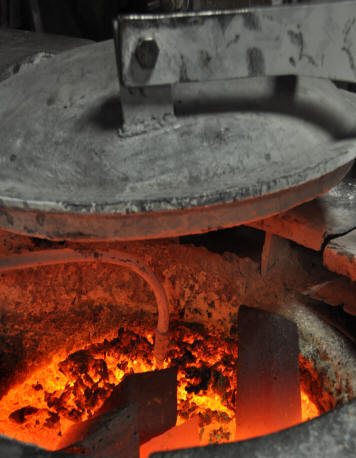Green Metalcasting

Not
many people think of green and metalcasting as two things that go together.
But they are. Following is a quick survey of examples of sustainable
practices in the foundry industry.
Metalcasting is the original sustainability industry. Metalcasters have been
recycling metals since before the Bronze Age. The earliest known copper
casting comes from 4004 BC. One can readily understand how rare and precious
copper was at that time. In our
company, a nonferrous foundry, well over 98% of the ingot we buy is
secondary metal. That means that rather than being made from ore that was
mined and smelted, secondary ingot is made from recycled metals.
Lean
Green 2.0 is a program led by Enterprise Minnesota with a grant from The
Minnesota Job Skills Partnership and technical assistance from the Minnesota
Technical Assistance Program. In-kind contributions come from the five
partner foundries. The partners are Dotson Iron,
LeSeuer Foundry, Smith Foundry, Pier Foundry and St. Paul Brass and Aluminum
Foundry. Lean Green 2.0 is using lean concepts to identify energy wastes in
foundry processes. Once identified lean concepts will be applied to reduce
or eliminate wasteful practices.
Metalcasters of Minnesota has successfully worked with the State of
Minnesota Pollution Control Agency to get approval for beneficial reuse of
foundry sand. Beneficial reuse is a fancy word for using the sand in other
projects so that it does not have to be landfilled. Projects include using
sand in flowable fill, composted soil, and roadbed materials. MCM is
beginning a new project this fall. Stay tuned for details.
Sustainable practices are those that responsibly manage resource uses. St.
Paul Brass and Aluminum Foundry (SPBA) is doing their part. In December of
2010 SPBA installed new sand reclaiming equipment in their airset
department. Prior to that time the foundry used a ratio of 60% reclaim sand
to 40% new. At that rate sand was being used an average of 1.5 times then
sent to a landfill. During 2011 the foundry worked to improve the
effectiveness of the sand scrubbing system. They recently reached
our step goal of 92% reclaim which resulted in 87% reduction in ladfill
waste from sand.
For
every truckload of new sand that a foundry buys they must landfill an equal
amount. SPBA used to buy new and landfill used at the rate of 25 tons a
week. Now it takes months to fill up a 10 yard rolloff container. Besides
the obvious benefits to the environment from both the mining and waste
stream ends of the resource life cycle, there are economic benefits to the
foundry. There are also unexpected benefits. Silica sand expands when first
heated. This expansion can cause casting defects. After a sand grain is
exposed to heat once subsequent heating does not cause nearly as much volume
change. Reuse of sand results in fewer defects.
Mechanically scrubbing sand has certain advantages. While excess spent
binder can result in gas related defects, a small amount on the sand grain
is beneficial. Binders do not wet well on bare silica. They wet extremely
well on silica that already has a small amount of binder adhering to it.
This results in the need for significantly less binder levels to achieve the
same strength. As much as 50% less. SPBA has been able to lower binder on
backing sand to 0.5%. Using less sand, less binder, and less landfill waste
add up to sustainable practice in the foundry.